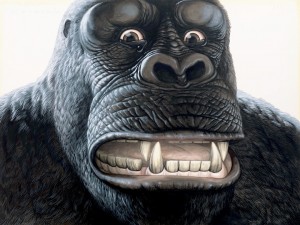It’s all happening in the Walton Ford zoo
I can’t wait to get back to Manhattan in December to visit King Kong. The one that Walton Ford has painted, that is. A very disturbed Mr. Kong makes a series of faces in Ford’s enormous paintings of him that seem like perfect icons of the flight-or-flight impulse that has kept things breathing on this planet for so many eons. At the Paul Kasmin Gallery, until Dec. 22, the massive ape will be hanging out with some of his fellow mammals from the imaginary menagerie Ford has conjured at his studio in the Berkshires. A couple of years ago, in a lecture I gave at the Memorial Art Gallery, I veered off topic to show some slides of Ford’s paintings and rave about them while chiding the artist for a remark he made in his New Yorker profile about how he was a little disappointed in himself for not advancing the course of art. Yes, I think we’re all probably a little melancholy about failing to do that, Walton—at least since I last checked—though some of us get over it by reminding ourselves what year it is. My point was that it’s silly to feel that way because, as Arthur Danto has pointed out, it became clear half a century ago that anything can be a work of art, so the notion that we’re advancing anywhere in the realm of visual art has outlived its use-by date. Anything qualifies now, so the notion of progress has done its job quite well and now we need to find a new and more personal, if not mysterious, imperative for making art. I think what Ford has done points the way as well as anyone else’s work these days. The challenge now is to create a visually coherent world other people will be eager to enter and explore—place they want to keep returning to see. More than almost any other artist working now, Ford has created a seductive world all his own that looks and feels enough like the world outside my door to seem initially recognizable—hey, I can watch hummingbirds get into violent turf wars without leaving my house and that scene would be perfectly recognizable as one of Ford’s. Yet his world is a bit more exotic than the average suburban back yard (though maybe not for those living in Ohio after that fellow released his private zoo to creep around in the night). The ways in which his visions differ from my own daily world are what make them an inexhaustible delight. I want to look, and look, and look.
Ostensibly, his images always stand for something. They’re always a metaphor, an allegory. He has said so. But they’re allegory as it functions in a Hawthorne story, made terribly specific and yet fundamentally ambiguous, impossible to dismiss with any explication as the sense of meaning spills out beyond whatever seems to be happening in the scene. They arrest the mind and evoke an oneiric response—they may be bloody, violent and full of animal passion, but it’s all subsumed in a daydream’s ontological stillness. You can’t pin his images to one particular significance, as much as he often seems to want you to, and actually, you don’t need to reduce them to anything other than what you see, they’re so luxuriant and rich. Stare at them as long as you like, they’ll keep revealing things. His sybaritic, besotted monkey or his cyclone of birds serve as magnets for a multiplicity of interpretations, until the mind gives up and is just drawn into the restful magic of an alternate universe built of watercolor. His work reminds me of the fantastic and minutely detailed renderings of Brueghel and Bosch as much as Audubon, and somehow Chris Van Allsburg’s illustrations also come to mind, their precision and handling of light and their timeless dreaminess. Maybe that’s because in Ford’s rarefied savagery, there’s always a feel of primal regression to the terrors and delights of childhood. The wild things have taken over in ways I find thrilling and beautiful. His scenes are often brilliantly illuminated, usually with intense color condensed into tiny areas the way a cherry tree delivers its sugar. He concentrates a rainbow into the face and gullet of an exotic bird, or a mango, or a pink talon. Every time you look at one of his paintings, you feel as if you’re just waking up, looking at the world with raw, new eyes, and you think, oh, wow! So this is where the real dreaming begins.

Comments are currently closed.